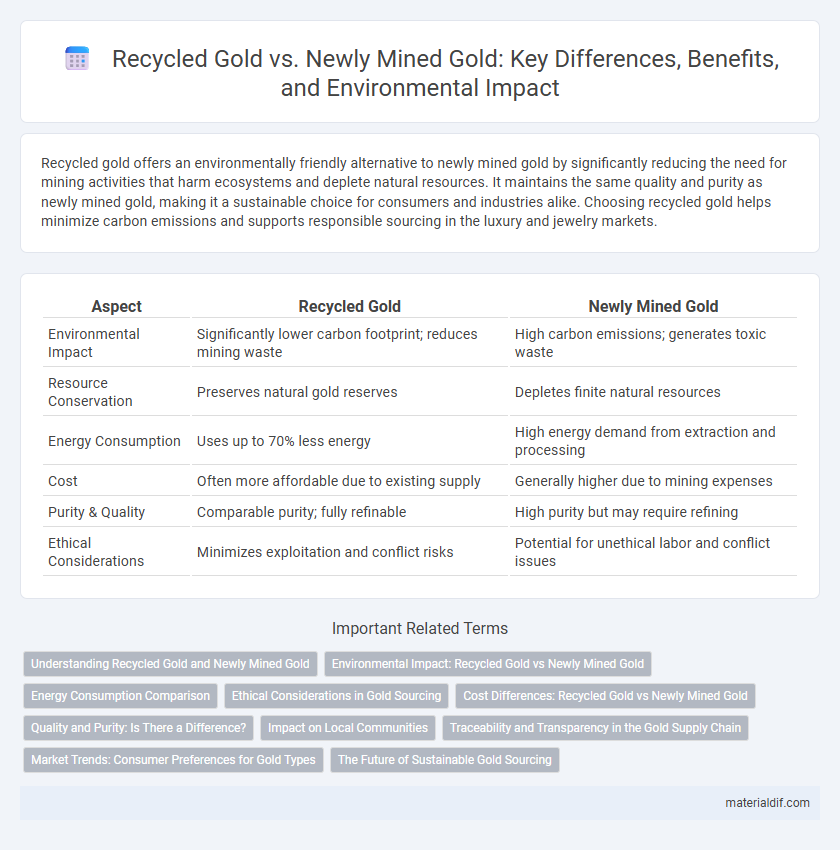Recycled gold offers an environmentally friendly alternative to newly mined gold by significantly reducing the need for mining activities that harm ecosystems and deplete natural resources. It maintains the same quality and purity as newly mined gold, making it a sustainable choice for consumers and industries alike. Choosing recycled gold helps minimize carbon emissions and supports responsible sourcing in the luxury and jewelry markets.
Table of Comparison
| Aspect | Recycled Gold | Newly Mined Gold |
|---|---|---|
| Environmental Impact | Significantly lower carbon footprint; reduces mining waste | High carbon emissions; generates toxic waste |
| Resource Conservation | Preserves natural gold reserves | Depletes finite natural resources |
| Energy Consumption | Uses up to 70% less energy | High energy demand from extraction and processing |
| Cost | Often more affordable due to existing supply | Generally higher due to mining expenses |
| Purity & Quality | Comparable purity; fully refinable | High purity but may require refining |
| Ethical Considerations | Minimizes exploitation and conflict risks | Potential for unethical labor and conflict issues |
Understanding Recycled Gold and Newly Mined Gold
Recycled gold is sourced from previously used jewelry, electronic components, and industrial waste, offering an eco-friendly alternative that reduces the environmental impact associated with traditional mining. Newly mined gold is extracted from terrestrial deposits through mining operations that often involve significant land disturbance, energy consumption, and chemical use. Understanding the differences between recycled and newly mined gold helps consumers make informed decisions based on sustainability, cost, and ethical considerations.
Environmental Impact: Recycled Gold vs Newly Mined Gold
Recycled gold significantly reduces environmental impact by minimizing the need for destructive mining practices that cause deforestation, soil erosion, and water pollution. Newly mined gold contributes to carbon emissions and habitat destruction through extensive excavation and chemical processing. Choosing recycled gold supports sustainable resource use and lowers the ecological footprint associated with gold production.
Energy Consumption Comparison
Recycled gold significantly reduces energy consumption compared to newly mined gold, using up to 90% less energy in the refining process. Mining new gold requires extensive extraction, crushing, and chemical processing, which collectively consume vast amounts of fossil fuels and water. Utilizing recycled gold not only conserves natural resources but also lowers greenhouse gas emissions associated with energy-intensive mining operations.
Ethical Considerations in Gold Sourcing
Recycled gold significantly reduces environmental impact by minimizing energy consumption and habitat destruction compared to newly mined gold. Ethical sourcing of recycled gold addresses concerns related to conflict minerals and labor exploitation often associated with mining operations. Choosing recycled gold supports sustainable practices and promotes transparency in the gold supply chain.
Cost Differences: Recycled Gold vs Newly Mined Gold
Recycled gold typically costs less than newly mined gold due to lower extraction and processing expenses, as it avoids the environmental and labor-intensive mining processes. The supply chain for recycled gold is shorter, reducing logistical costs and enabling more competitive pricing. Market demand fluctuations influence both types, but recycled gold remains a cost-effective alternative for sustainable jewelry and investment purposes.
Quality and Purity: Is There a Difference?
Recycled gold undergoes thorough refining processes to match the quality and purity standards of newly mined gold, often reaching 99.99% purity levels. Both sources produce gold that meets industry benchmarks for use in fine jewelry and electronics, ensuring no compromise in material integrity. The recycled gold's molecular structure remains identical to newly mined gold, making it indistinguishable in terms of quality and performance.
Impact on Local Communities
Recycled gold significantly reduces the environmental degradation and displacement often associated with newly mined gold, benefiting local communities by preserving land and water resources. Newly mined gold extraction frequently causes deforestation, soil erosion, and pollution, leading to adverse health effects and loss of livelihoods for indigenous and local populations. Utilizing recycled gold helps mitigate these impacts, promoting sustainable practices and supporting community well-being.
Traceability and Transparency in the Gold Supply Chain
Recycled gold offers superior traceability and transparency compared to newly mined gold due to its established chain of custody and reduced environmental impact. Advanced tracking technologies and certification programs enhance the visibility of recycled gold's origins, ensuring ethical sourcing and compliance with responsible mining standards. In contrast, newly mined gold faces challenges with opaque supply chains, risking association with conflict minerals and unregulated practices.
Market Trends: Consumer Preferences for Gold Types
Consumer preferences are increasingly favoring recycled gold due to growing environmental awareness and demand for sustainable luxury. Market trends indicate a rising shift as recycled gold offers reduced ecological impact compared to newly mined gold, appealing to eco-conscious buyers and ethical investors. This shift is driving jewelry brands and retailers to highlight recycled gold collections and transparent sourcing practices in response to evolving consumer values.
The Future of Sustainable Gold Sourcing
Recycled gold offers a sustainable alternative by significantly reducing the environmental impact associated with newly mined gold, including habitat destruction and carbon emissions. Innovations in refining technologies and increased transparency in supply chains are driving the growth of recycled gold within the jewelry and electronics industries. As consumer demand shifts towards ethical sourcing, recycled gold is positioned to become a cornerstone of the future gold market, promoting circular economy principles and reducing reliance on traditional mining.
Recycled Gold vs Newly Mined Gold Infographic

 materialdif.com
materialdif.com